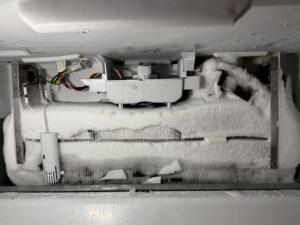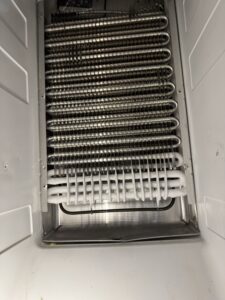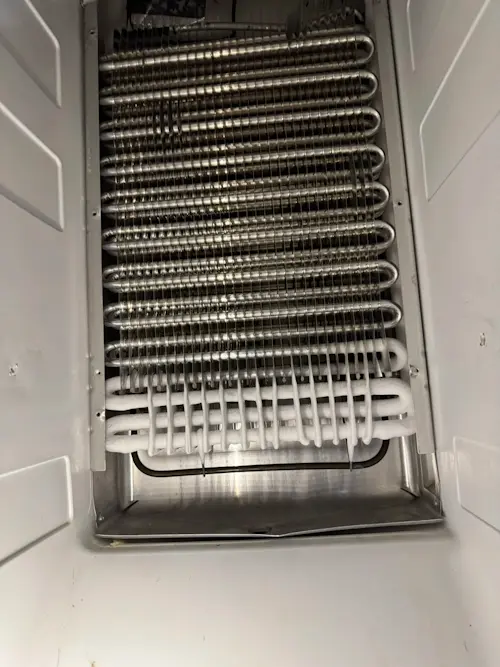It’s a common and frustrating question, especially in hot states like Texas: Why is my refrigerator not cooling?
At HomeFix Appliance Repair, we’ve been serving Houston and surrounding areas for years, diagnosing and repairing refrigerators of all types and brands. We want to share our expertise to help you understand the possible causes of a non-cooling refrigerator, ways to diagnose the issue, and when you might need professional repair.
1. Faulty Compressor or Start Relay Issue
One of the most frequent causes of a warm refrigerator is a non-working compressor. You may notice that:
- The interior light is on.
- You hear noises from the back of the fridge (likely from the condenser fan).
- The inside of the fridge is warm.
A common culprit is a faulty start relay. Since relays have mechanical parts, they tend to wear out over time, preventing the compressor from starting. However, since compressors operate quietly, you might confuse the condenser fan noise for compressor activity.
How to Diagnose:
- Access the compressor (typically located at the back, near the bottom of the fridge).
- Listen carefully to see if the compressor is vibrating or making a low humming sound.
- Use a non-contact infrared thermometer to check the compressor’s temperature (normal range: 80-120°F).
- If unsure, carefully touch the compressor using a gloved hand—if there is no vibration, the compressor is likely not running.
⚠ Safety Warning: Be cautious when working near moving parts like the condenser fan. The compressor can also get extremely hot, so using a non-contact thermometer is the safest approach.
Solution:
If the compressor is not running but the condenser fan is, replacing the start relay may solve the issue. However, if the compressor still won’t start, it may need professional diagnosis or replacement.
2. Frozen Evaporator Coils in the Freezer
If your defrost system is not working, the evaporator coils inside the freezer can become covered with frost or ice, blocking airflow and preventing proper cooling in both the freezer and fridge sections.
How to Diagnose:
- Remove the evaporator cover in the freezer.
- Check if the coils are frozen over.
- If they are completely encased in ice, your defrost system is likely malfunctioning.
Solution:
Fixing a broken defrost system requires further diagnosis, which we’ll cover in a separate article. However, you can try a manual defrost by unplugging the fridge for 24 hours to melt the ice. If the problem reoccurs, the defrost heater, defrost thermostat, or control board may need replacement.

3. Low Refrigerant (Freon Leak)
A refrigerator with low refrigerant won’t be able to cool properly, usually due to a freon leak in the sealed system.
How to Diagnose:
- Remove the evaporator cover in the freezer.
- Check if the entire coil is evenly covered with frost.
- If only part of the coil has frost, you likely have a refrigerant leak.
⚠ Warning: Handling refrigerant requires special licensing, and DIY repairs are not recommended.
Solution:
Call a certified refrigeration technician to handle the issue. At HomeFix Appliance Repair, we have extensive experience, including working with high-end refrigerators.

4. Faulty Temperature Sensors (Thermistors)
If the temperature sensor (thermistor) is defective, it may send incorrect readings to the refrigerator’s main control board, causing the compressor to cycle improperly or not turn on at all.
How to Diagnose:
- Use a multimeter to check the resistance of the thermistor.
- Compare the reading to the manufacturer’s specifications.
⚠ This requires technical knowledge, so DIY repair is not recommended.
Solution:
A faulty thermistor should be replaced, but since this involves testing electrical components, it’s best to call a professional.
5. Refrigerator Not Cooling Enough
Sometimes, when people say “my fridge is not cooling,” they mean it is cooling, but not as well as before. For example:
- A month ago, your ice cream was rock solid, but now it’s softer than usual.
- The fridge is colder than room temperature but not as cold as it should be.
There are over 10 possible reasons for weak cooling, and accurate diagnosis requires experience and knowledge of refrigeration systems.
However, as a user, you can do the following:
✔ Check condenser coils for dust buildup – pet hair and dust can clog them, reducing cooling efficiency.
✔ Ensure proper airflow inside the fridge – avoid overloading shelves, as this blocks air circulation.
✔ Schedule annual maintenance – just like cars need servicing, so do refrigerators.
Need a Professional Refrigerator Repair in Houston?
If you live in Houston, Katy, Sugar Land, Pearland, The Woodlands, or Cypress, we can:
✔ Diagnose the issue correctly
✔ Repair your refrigerator efficiently
✔ Advise if buying a new fridge is a better option


4 Responses
Hi! I have a question. How can I check the thermal sensor in my refrigerator? Bcs my freezer is cooling properly, but the fridge section is still warm. I see the thermal sensor on the right side of the fridge, and I’d like to check it.
Hi John! Great question — and you’re on the right track.
If your freezer is cooling but the fridge section stays warm, the thermal sensor (also called a thermistor) is one of the first things to check.
Here’s how you can test it:
1. Unplug the fridge for safety.
2. Remove the sensor (usually clipped or mounted with a small connector).
3. Use a multimeter set to measure resistance (Ohms).
4. At room temperature (~70°F or 21°C), the sensor should show around 9kΩ–12kΩ (depending on the brand/model).
5. If the reading is outside that range — or shows 0 or infinite resistance — it likely needs replacement.
Also, make sure there’s no ice buildup around the air vents or behind the rear panel in the freezer. That could also block airflow into the fridge section.
If you’re not sure about the readings — feel free to reply with a photo or model number. We’ll be glad to guide you further!
Great breakdown of common fridge cooling issues! I had no idea a faulty start relay could cause such a major problem. Do you have any quick troubleshooting tips to determine if it’s the start relay before calling a professional?
Thanks for the feedback — glad you found the article helpful!
Yes, a faulty start relay is a surprisingly common reason a fridge won’t cool properly, especially when the compressor doesn’t run consistently.
Here’s a quick way to test it:
1. Unplug the fridge first (safety first!).
2. Locate the start relay — it’s usually a small black or white box attached to the side of the compressor.
3. Gently remove the relay and shake it.
• If you hear a rattling sound, that’s often a sign it’s burned out.
4. You can also test it with a multimeter (resistance between the relay terminals should not be open or infinite).
5. If the compressor works after replacing the relay (they usually cost around $10–$20), you’ve found your fix.
If that doesn’t help — it may be a deeper compressor or control board issue, and at that point we’d recommend a pro diagnosis.
Let us know if you’d like help or want us to check it for you!